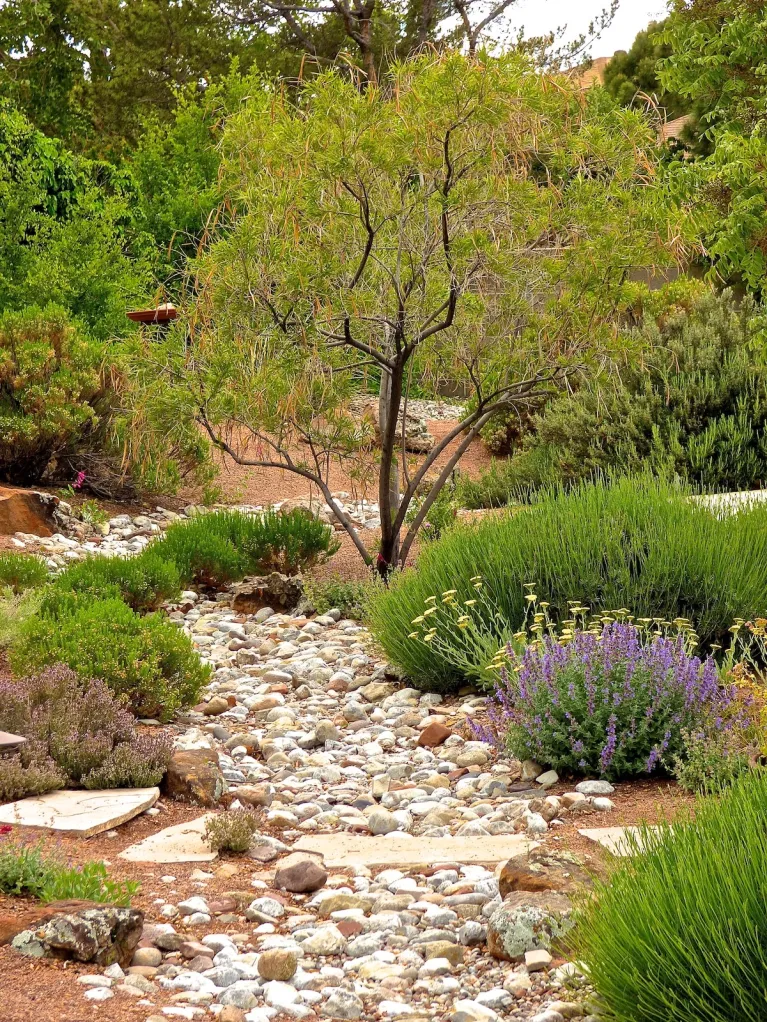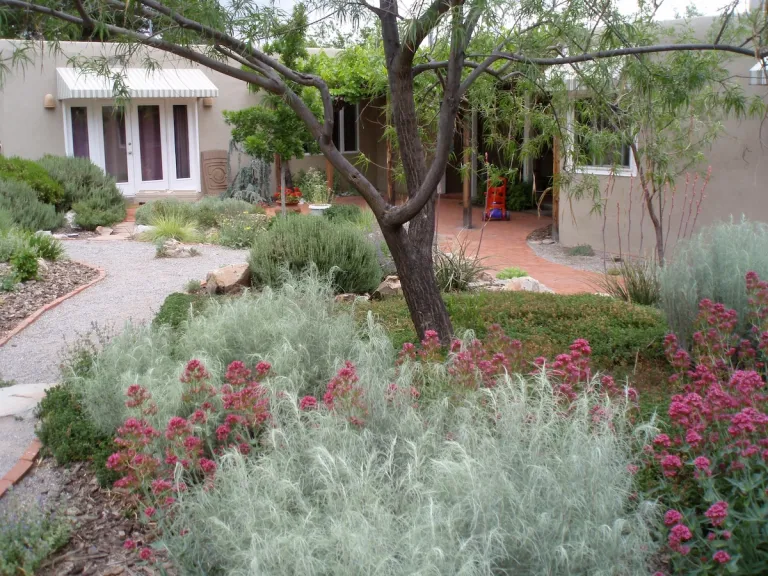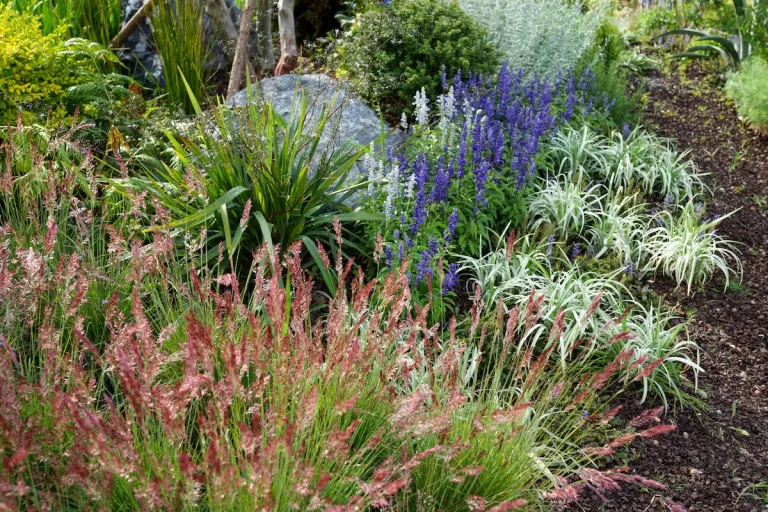Many people think xeriscaping means a barren yard filled with gravel and little color—but that’s a misconception. Simply removing all plants except one tree and surrounding it with gravel can actually harm the tree and does little for water conservation.
While saving water is central to xeriscaping, it shouldn’t come at the cost of a vibrant landscape, says Judith Phillips, author and owner of Judith Phillips’ Design Oasis in Albuquerque. With smart planning, you can conserve water while maintaining beauty, biodiversity, and cooler outdoor spaces. The xeriscape ideas below promote sustainability, pollinator support, and resilient, colorful landscapes.
Choose Regionally Adapted Native Plants
Understanding your local environment is key before buying plants. Landscape experts Judith Phillips and Hunter Ten Broeck of WaterWise Landscapes in Albuquerque stress selecting plants suited to your region—not just native over exotic, but those best adapted to your specific soil, rainfall, and climate. Ten Broeck recommends working with local experts and sourcing plants locally whenever possible.
Native plants typically require less water, support pollinators and wildlife, and demand less upkeep. Because they’re naturally resilient, they’re more likely to survive their first year—saving you time, money, and water.
Read More: Must-Have Dishwasher Feature You Didn’t Know Existed
Replace Excess Gravel with Mulch or Living Ground Cover
Covering your yard with landscape fabric and gravel might seem low-maintenance, but it often creates hotter, less appealing spaces—and can even harm plant life. Judith Phillips notes that this trend contributed to Albuquerque’s rising urban tree loss in the early 2000s. Removing turf without replacing its cooling and moisture-retaining benefits often leads to tree decline.
Gravel absorbs and radiates heat, increasing a tree’s moisture needs without replenishing them. Phillips recommends using organic alternatives like shredded wood mulch, pecan shells, compost, or xeriscape-friendly ground covers beneath trees. These options cool the soil and help retain moisture—benefits that extend to most shrubs and flowers, excluding only the most heat-tolerant varieties.

Add Shade to Boost Comfort and Efficiency
With rising temperatures across the Southwest, shade plays a critical role in sustainable landscaping. “Shade is becoming more important,” says Hunter Ten Broeck of WaterWise Landscapes. Trees can lower ground temperatures by 10 degrees or more and slightly increase humidity, creating a more comfortable outdoor space and protecting sensitive plants from harsh afternoon sun.
Strategically planting trees—especially on the southwest side of your home—can also reduce indoor cooling costs. For shaded areas, choose drought-tolerant ground covers that thrive without full sun. Ten Broeck recommends creeping germander and dwarf plumbago for their hardiness and visual appeal in low-light zones.
Capture and Redirect Rainwater Efficiently
Collecting rainwater in barrels or cisterns is a smart, water-saving strategy for xeriscaping—but it’s just one option. You can also redirect rainwater to irrigate trees and plants naturally. Features like dry river beds made of gravel and rocks help slow runoff, guiding it to where it’s most needed while enhancing your landscape’s design.
This method also works well in areas with heavy rainfall. “You may have too much water—so how can you guide it away from areas that might flood?” says Hunter Ten Broeck. Redirect excess water toward drought-tolerant plants that benefit from moisture without being overwhelmed. Designs like dry river beds offer both function and beauty in sustainable landscaping.
Sustain Tree Health with Smart Irrigation
Sustainable tree care starts with proper irrigation and moisture retention. If rainwater can’t reach your tree, help the soil hold moisture using mulch instead of gravel or landscape fabric. Drip emitter placement is crucial—avoid placing them near the trunk, where roots won’t benefit. “A mature shade tree may extend roots 80 feet or more,” says landscape designer Judith Phillips.
Instead, create planting pockets farther out and install drip emitters with each plant to encourage widespread rooting. “The tree’s roots will seek water, and companion plants help share that moisture,” Phillips explains. Ten Broeck adds drip tubing in a spiral, with emitters every 12 inches, and includes drought-tolerant ground covers to support tree growth over time.

Plant for Year-Round Diversity and Resilience
A diverse xeriscape garden offers more than beauty—it supports pollinators and strengthens your landscape’s health. Hunter Ten Broeck designs with seasonal blooms in mind to ensure color and interest year-round through flowers, foliage, and ornamental grasses. This approach also fosters habitat for bees, birds, and other wildlife.
Too much of one species increases vulnerability to pests and disease. Judith Phillips emphasizes limiting lawns and incorporating native grasses, wildflowers, and shrubs instead. These not only boost biodiversity but also provide essential ecological value. The more varied your plantings, the more balanced and resilient your yard becomes.
Create a Thriving Wildlife Habitat
Planting a variety of native species doesn’t just enhance visual appeal—it builds a healthy ecosystem. “Grass is a waste of water; it’s a green desert in terms of habitat value,” says Judith Phillips. Native plants evolved alongside local wildlife, offering the food and shelter that turf simply can’t provide.
A wildlife-friendly yard can be both beautiful and sustainable. “It’s about getting the most value for the water you’re putting on the landscape,” Phillips adds. Consider pursuing habitat certification to boost your yard’s ecological impact. “The goal is to create a web of habitat,” says Hunter Ten Broeck—one yard at a time.
Group Plants by Water and Maintenance Needs
A diverse xeriscape doesn’t have to mean complicated upkeep. One key principle is zoning—placing thirstier plants near the house (an “oasis zone”) and transitioning to drought-tolerant plants farther out. More important than strict placement, though, is grouping plants with similar water and care needs.
“Zoning by water is essential, but I also consider maintenance,” says Hunter Ten Broeck. “Larger, low-maintenance plants belong farther away.” If you’re designing a rain garden or dry river bed, locate higher-water plants where rain naturally pools. Just avoid using the same drip system for water-hungry non-natives and drought-resistant species.

Build Healthy Soil for Long-Term Water Savings
Healthy soil is key to a thriving xeriscape. Over time, improving soil structure boosts permeability, allowing better air and water flow. Simply adding organic matter to a planting hole won’t help much if surrounding soil remains poor—it’s the broader soil health that supports lasting growth.
Judith Phillips prefers shredded wood mulch over bark, as it breaks down on the surface and feeds beneficial mycorrhizae. These fungi form symbiotic relationships with tree roots, enhancing water and nutrient absorption. Compost, pecan shell mulch, and cover crops also enrich soil, though results may take time. Healthier soil cools roots, retains moisture, and supports more resilient plants.
Avoid Landscape Fabric in Planting Areas
While landscape fabric may reduce some weeds, it disrupts soil health by blocking the natural breakdown of organic matter. Covering it with mulch doesn’t help—rain struggles to penetrate, especially through woven materials, and black plastic is even worse. “Water only seeps through once it’s saturated—and then slowly,” says Judith Phillips.
Fabrics also hinder plant spread. Ground covers and flowers that reseed or grow by runners can’t thrive, and aggressive weeds often find their way through cracks and edges anyway. For best results, limit fabric to pathways where it can reduce weeds under materials like crusher fine that don’t decompose like organic mulches.
Swap Turfgrass for a Low-Water Ornamental Grass Meadow
Replacing traditional turf with ornamental grasses creates a beautiful, low-maintenance alternative that supports xeriscaping goals. Native grasses can still offer small, usable lawn areas for pets and kids, but all turf requires occasional spray irrigation—which is less efficient than drip or soaker systems.
Ornamental grasses offer a meadow-like look with lower water needs and greater adaptability to drip irrigation. “You can create that meadow effect using mass plantings of ornamental grasses,” says Hunter Ten Broeck, who replaced his native grass and wildflower area for a more water-wise design.

Choose Permeable Hardscaping to Reduce Runoff
Traditional hard surfaces prevent water from soaking into the ground, leading to runoff, flooding, or pooling. Permeable materials like porous asphalt, concrete, and pavers allow water and snow to seep into the soil—reducing runoff and supporting groundwater recharge, even in rainy regions.
“Some areas deal with too much water,” says Judith Phillips. Permeable hardscaping offers a sustainable alternative for driveways, patios, and walkways. You can even harvest rainwater this way. In one project, Hunter Ten Broeck designed a parking lot where permeable paving drained water into cisterns—capturing rainfall instead of letting it go to waste.
Plan for the Mature Size of Trees and Shrubs
Choosing plants without considering their mature size can lead to crowding, poor airflow, and maintenance issues. “Plant them for the size they’ll be in 10 years,” advises Hunter Ten Broeck. Overgrown trees and shrubs can block each other’s growth and reduce overall plant health. Be sure to place drip emitters with mature size in mind, too.
New xeriscapes often take time to fill in, so don’t worry if things look sparse at first. For quick color, Ten Broeck suggests adding short-lived perennials to fill gaps temporarily while permanent plants establish.
Match Plants to Microclimates in Your Yard
Choosing the right plant isn’t just about hardiness—it’s also about placement. Mature size influences shade, so consider how trees will eventually protect heat-sensitive plants from afternoon sun. A perennial labeled cold-hardy may still struggle if planted on the north side of your home where frost lingers.
Sun-loving plants may overheat in rock gardens, while moisture-loving ones do best in low spots that collect water. Drought-tolerant plants prone to root rot need well-drained areas that dry out between rains. Beyond zoning by water and maintenance, match each plant to the specific light, soil, and moisture conditions it needs to thrive—and how it may affect surrounding plants.
Use a Thick Layer of Organic Mulch
Mulch is one of the most effective tools in xeriscaping. A 3-inch layer of organic mulch helps suppress weeds, regulate soil temperature, and enrich poor soil—especially in drought-prone regions. It also cools plant roots, which is vital in increasingly hot climates.
Because organic mulch breaks down over time, it needs replenishing every few years. Judith Phillips recommends leaving fallen leaves under trees and topping them with a light layer of mulch. “You’re returning exactly what the tree has used,” she says. “It’s a simple, natural form of recycling.”
Frequently Asked Questions
What is xeriscaping, and how is it different from traditional landscaping?
Xeriscaping focuses on water-efficient design using drought-tolerant plants, soil improvement, and smart irrigation. Unlike traditional landscaping, xeriscapes reduce or eliminate the need for supplemental watering.
Can a xeriscape yard still look green and colorful?
Yes! A well-designed xeriscape can be lush, vibrant, and full of color. By choosing regionally adapted plants that bloom in different seasons, you can create a dynamic and beautiful landscape year-round.
Do I have to remove all grass to xeriscape my yard?
Not necessarily. You can replace high-maintenance turfgrass with native grasses or ornamental alternatives in small, functional areas—especially those used by kids or pets.
Is xeriscaping expensive to install?
While initial costs can vary, xeriscaping often saves money long-term through lower water bills, reduced maintenance, and fewer lawn care products. Many cities also offer rebates or incentives for xeriscape conversions.
What kind of mulch works best in xeriscaping?
Organic mulches like shredded wood, bark, pecan shells, or compost are ideal. They retain moisture, regulate soil temperature, and break down to enrich the soil naturally.
How do I water a xeriscape yard effectively?
Drip irrigation systems work best. Group plants with similar water needs, and water deeply but infrequently to encourage strong root systems.
Can I include trees and shrubs in a xeriscape?
Absolutely. Trees provide shade, reduce water evaporation, and create microclimates. Choose native or drought-tolerant varieties and place them strategically for cooling benefits.
Conclusion
Xeriscaping offers more than just water savings—it’s a smarter, more sustainable way to create a vibrant and resilient landscape. By choosing regionally adapted plants, grouping them by water and maintenance needs, improving soil health, and using shade and mulch strategically, you can build a yard that thrives year-round with less effort and fewer resources.











